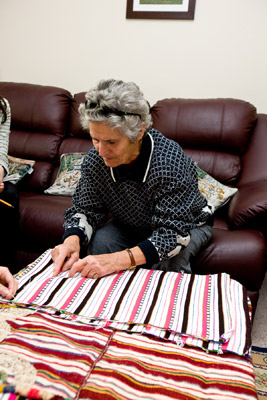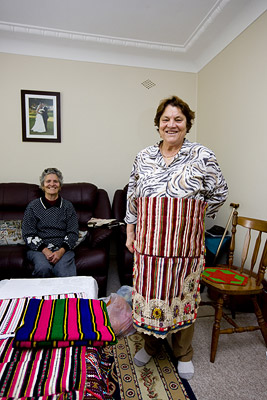
Woven from her heart
Lindie Ward, Curator Design and Society, Powerhouse Museum
Kostadinka Jordeska with her sister Spasija Aleksoska's unfinished apron, showing how the stripes are reversed prior to seaming. Photo by Marinco Kojdanovski.
A dazzling array of over 40 Macedonian aprons from the Ohrid, Bitola and surrounding areas of Macedonia came to light through the Macedonian apron project initiated by Meredith Walker and Mendo Trajcevski. The vivid color combinations, eccentric stripes and patterns of the aprons are full of strength and vitality.
The primary visual impact of most of the hand-woven aprons is the clash of stripes in the central vertical or horizontal seam. Many of the aprons are made from coarse, handspun wool. Some more recent ones include mercerized cotton and other threads. A 30 centimetre wide length of fabric was tapestry woven on a cotton warp with a pattern of multicoloured weft stripes in repeated groupings. Every Macedonian house would have had its loom. Several women we spoke to were able to demonstrate the pedal and hand movements they used to operate the loom, despite not having done this for many years.
In the villages in the Ohrid region the traditional method was to fold the finished woven length in two, cut it on the fold, hem the sides, and hand-stitch the centre seam along the selvedges. The asymmetrical stripe sequence has thus been intentionally reversed to mismatch. The women insisted that this was ‘just how it had to be’. The large stitches of the central seam stiffen it and prevent it from lying flat. Once the apron is complete it is then folded twice into thirds and stored this way. These folds, the seam and the coarse wool render the apron very rigid. Further bindings around the edge of some aprons and across the centre make them even more substantial.

Spasija models the aprons in her home in Coniston, Wollongong. Photo by Marinco Kojdanovski
Apron ties of fabric, cord or plaited wool are sewn by hand or machine to the top edge, the corner sometimes folded at 45 degrees to strengthen it. Others have finely worked loops at the top edge through which a 10 metre long cord, sometimes made from horsehair, would be crossed several times around the diaphragm.
A traditional bridal outfit from Bitola could weigh many kilograms and might consist of nine garments with quantities of silver jewellery. Each region originally had its own specialities, a certain weft pattern or colour, but this became less prevalent as the 20th century progressed. Some aprons feature complex multi-coloured weft patterns with tapestry woven lozenges or ‘birds’, and rhomboids. More recent aprons in this collection, made as mementoes, are highly elaborate with traditional decorations including pompoms, lace and sequins.
Traditionally if a woman lived in an isolated area she would purchase dye and sewing threads from a travelling salesman. She would boil up the wool and set the colour with vinegar. The owners of the Illawarra aprons were not familiar with the home grown natural dyes used by their great great grandparents. However the designs for the women’s handwork were passed down through the generations from existing examples.
Once a girl was engaged she spent her winter months creating gifts to give her family and new in-laws. Friends would assist, staying awake until the early hours to complete everything. In addition to numerous hand-woven linen chemises and aprons for herself, she would make 20 to 30 aprons for relatives and in-laws, presented in a large chest. Darker ones were presented to older women. A dark mourning apron might be needed and would be worn for one to three years. Between 30 to 40 pairs of brightly patterned socks would be placed around the men’s necks at the ceremony and a satchel was made for the best man to carry the ceremonial sweet bread for the wedding, a lively occasion with dancing and glorious costumes.
Wearing a newly made apron, the new bride went straight to work in the fields from dawn to dusk. Most aprons were eventually worn for working, even though first worn for best. Despite intense pressure to produce children as quickly as possible, women took pains to hide their pregnant stomachs under their aprons, avoiding inquisitive eyes. Nineteen year old Spasija Aleksoska, who was very slim, wrapped towels above and below her growing stomach, under her apron, so she looked substantial (the favoured look) but not pregnant. She worked in the fields until eight months pregnant. There was no time to weave aprons now. The baby would accompany its mother to the fields.
It is no wonder these aprons were brought to Australia. They symbolised a woman’s life and hid her secrets. These vibrant creations, traditionally made entirely from the local environment, by brisk, skilled hands, represent the strength, energy and resilience of Macedonian women.
I would like to thank Angelina Todoroska, Spasija Aleksoska, Kostadinka Jordeska, Blaguna Nikolovska and Menka Karanfilovska for sharing their apron experiences and Verica Sajdovska for her thoughtful interpretation.